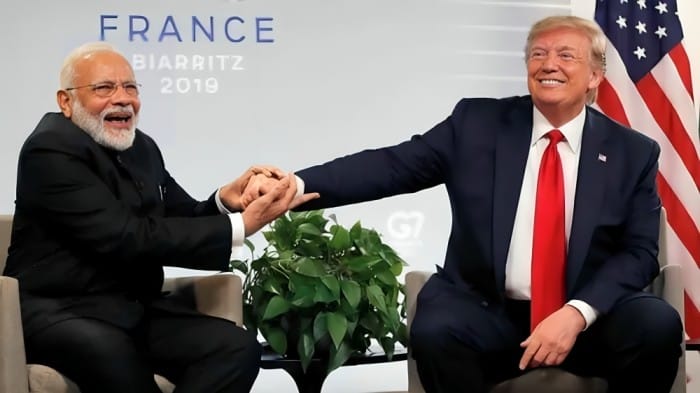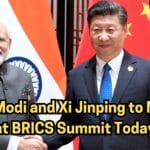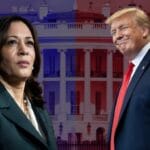With the 2024 US presidential election looming large, Donald Trump, who has once again plunged into the fray as the Republican candidate, is re-entrenching himself into the public view with policies on foreign affairs, trade, defense, and immigration-all of which are again coming under scrutiny, not just at large but especially by India. Over the last few decades, India and the US have been developing a relationship that only seems to be getting stronger and stronger, and the possible return of Trump to the White House is likely to either propel that development forward or introduce new complexities depending on how things fall in place.

Trump and Modi: A Friendship of National Interests
On X, formerly Twitter, Trump said in a message to the Indian diaspora that he and Indian Prime Minister Narendra Modi had a close friendship, especially considering that he addressed the community during the Diwali season. This is not the first time that Trump has pointed out that he has a good relationship with Modi, both leaders have a very nationalist approach to governance, as Modi’s “India First” echoes Trump’s “America First.” This friendship, however, also presents unique challenges. As both leaders have very nationalist agendas, they may have to balance cooperation with self-interest. In the past, high-profile events like the “Howdy, Modi! These, along with the rally in Texas and Trump’s visit to India, have brought international focus to their rapport.
While this bodes well for both in terms of politics, there is a prospect that the goodwill will prove difficult when it comes to practical trade and economic policies.
Economic and Trade Policies for India?
Trump’s trade policies have been extremely America-focused, they have left many an ally in a tough situation. Under his presidency, Trump focused on trade balances that served the US and often made public attacks on countries whose tariffs were too high. Of them is India, whom he has praised along with Modi but also accused of being a “big abuser” of the practice of trade.
Against this backdrop, it is almost certain that a Trump administration will ask India to reduce some trade barriers or threaten to raise tariffs on exports such as textiles, IT services, and pharmaceuticals. However, it is not all gloom. Trump has continually demonstrated his intent to reduce the U.S. dependence on China by forcing corporations to take their sourcing or supply lines outside the land. Relocation could prove to be a real opportunity for India if it can persuade American businesses to move away from China to markets with amicable cordial relations, such as India.
READ | U.S. Election 2024: Trump Takes Lead Over Harris in Crucial Swing States
With a Trump victory, we might see India trying to position itself as one of the prime alternative providers to US companies and that would be an effective victory for the Indian economy.
Defense and Security: Strategic Alignment Against China
As far as defense and security go, Trump’s policy very well aligns with Indian sentiments about China. Trump’s administration had already developed the Quad alliance of the US, India, Japan, and Australia as an opposition to the rise of China in the Indo-Pacific region. In his second term, he will likely enhance the relationships and push more for military exercises together with, perhaps also increasing weapons sales to India.
Indian military capacity building is also in mutual interest because the relations between India and China are complex and between India and Pakistan, too.
READ | US Imposes Sanctions on Indian Companies for Allegedly Supplying Russia’s Military
Trump’s stance on security is robust; he is a proponent of “Peace through Strength,” which has translated into taking a very hard line on defense. This may translate into further defense cooperation and potentially even technology transfers that can only help India’s military-industrial complex. If this partnership does deepen, India could well feel more secure in its approach to regional security issues with the United States at its back very positive development.
Immigration and H-1B Visa Policies: What Lies Ahead?
On immigration, however, Trump’s policies are going to pose very different sets of challenges. During his first term, he enforced tighter restrictions on the H-1B visa program affecting thousands of Indian professionals working in the US, mainly in the technology and engineering sectors. This approach repeated during his second term would curtail more opportunities for Indian skilled workers in the US, a situation that may compel Indian tech companies to expand elsewhere or even create more jobs at home.
This might sound draconian, but others say that if the H-1B program is made tougher, then the IT sector in India will expand within India. When Indian talent is not so free to flow to the US, it can lead to a spurt of innovation in India, which would also help further the self-reliance agenda in India. For most Indians dreaming of a job in the US, however, the visa policies of Trump will be one more hurdle to clear.
Geopolitical Impact of Power Dynamics in South Asia
Many Trump policies for South Asia happen to revolve around his intent in counter-terrorism, which he might use in his overall favor for the region following Indian regional interest. He seemed willing to discuss various issues with Pakistan but always demanded that they prove how they had tackled their elements of the same and proven their capability. Such behavior would also align well with the Indian interests of combatting terrorism coming from both of the regions near their borders. The administration of Trump might press harder to end all kinds of extremism, which may not be well for the cause of Pakistan.
Moreover, public condemnation of violence against Bangladeshi minorities by Trump is of interest to the India-related politics of the region. In this regard, with the increasing tension in South Asia as a consequence of the exiled prime minister of Bangladesh, Sheikh Hasina, seeking shelter in India, the opinions of Donald Trump may either make the issue stabilizing or more complex.
Conclusion: Chances and Challenges
While Trump’s second coming brings both opportunity and obstacles for India, however, the relationship between India and the United States stands poised to continue on an upward trajectory, though there certainly will be friction points along that path. In some respects–such as defense, based on his strong stance toward China and his emphasis on alliances as strategic tools, then India will benefit, as it has in past policy. In others–especially immigration and trade, that is, where it clashes with the current dynamic regarding economic and professional exchange opportunities–India may have tough sledding ahead.
Ultimately, Trump’s second term would test how well the United States and India balance their national interests with partnership benefits. If India can extract a good fit of the Trump policies along its lines of priorities, there may be significant payoffs, but only time will tell whether both sides can strike the right balance between friendship and strategic self-interest.
Analysis by Atul Raj






